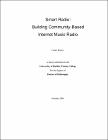| dc.contributor.advisor | Cunningham, Padraig | |
| dc.contributor.author | Hayes, Conor | |
| dc.date.accessioned | 2006-06-19T14:48:22Z | |
| dc.date.available | 2006-06-19T14:48:22Z | |
| dc.date.issued | 2003-10 | |
| dc.date.submitted | 2005-09-28T14:48:22Z | |
| dc.identifier.uri | http://hdl.handle.net/2262/845 | |
| dc.description.abstract | The success of file-sharing networks demonstrates that there is a huge potential market for digital
music services, if the music industry can find a service model that is attractive to listeners. The
concept of digital distribution is appealing to the music industry, because it suggests the possibility
of direct access to the consumer. In this thesis, we present Smart Radio, a prototype for an
alternative distribution approach, one in which the consumers themselves are producers, building
playlists of music which can be streamed to like-minded listeners. In this approach the service
provider is an enabler of community and social processes, allowing information and
recommendations to flow between users of the system, rather than engaging in targeted marketing.
However, developing recommendation and personalisation techniques for music systems is
problematic. Whereas information retrieval systems use keyword extraction to represent the subject
matter of a document for indexing and retrieval, the comparable process for audio artefacts is still a
subject of much research. The alternative is to rely on human input for content-description which
can be a knowledge-intensive process. Automated Collaborative Filtering (ACF) is a technique
which uses user ratings as a means of countering the problem of content elicitation. One serious
drawback with ACF is that it is not sensitive to a user?s interests at a particular moment. ACF
recommendation sets typically contain a mix of items reflecting the user?s accrued interests, rather
than localised interests. We solve this problem using a Case-Based Reasoning (CBR) technique, in
which we rank ACF recommendations according to their similarity to the user context. We call this
technique context-boosted ACF. We define the context using a case-like representation of the user?s
last playlist. The case representation describes the composition of a playlist in terms of the basic
meta-tags we have been able to extract from each mp3 file associated with the playlist. | en |
| dc.description.abstract | We
consider the light-weight case representation we use to be appropriate for an extension to ACF,
which is often used in domains where content description is scarce.
Increasingly, there has been a demand for objective evaluation criteria for automated
recommendation systems. Conventional off-line techniques are not suitable for directly comparing
recommendation strategies that produce different types of ranking, such as ACF and context-boosted
ACF. We introduce a novel on-line evaluation technique in which two algorithms simultaneously
compete to provide the user with recommendations. Unlike the off-line analysis, the on-line
methodology judges the relative degree of success of each strategy according to whether
recommendations were used by the on-line user. Our experiment, conducted over 15 weeks, found
context-boosted ACF to be significantly more popular than ACF for all usage ranges.
We demonstrate that the ACF mechanism is similar to an interactive CBR technique called
case completion in which an incomplete target query is incrementally filled out in an interactive
iv
dialogue with the user. Using this insight we address some of the problems inherent in ACF
systems such as query efficiency and memory overhead by applying techniques used in CBR. We
implement our ACF component using a Case Retrieval Net (CRN) which reduces memory
overhead by storing each feature-value pair once. We demonstrate how the calculation of the
Pearson coefficient can be distributed among the nodes of the CRN. It has been recognised in ACF
literature that the use of this measure is a computational bottleneck when calculating neighbours
from a large set of users. Accordingly, we showed how retrieval time is speeded up because local
similarity calculations are performed once for each node and distributed to indexed cases. Given
that the structure of CRNs can be adapted for parallel processing, we suggest that this technique
can be extended for large ACF data sets. | en |
| dc.format.extent | 62776141 bytes | |
| dc.format.mimetype | application/pdf | |
| dc.language.iso | en | en |
| dc.relation.hasversion | TCD-CS-2005-62.pdf | en |
| dc.subject | Computer Science | en |
| dc.title | Smart Radio: Building Community-Based Internet Music Radio | en |
| dc.type | Doctoral | |
| dc.type | Doctor of Philosophy (Ph.D.) | |
| dc.publisher.institution | University of Dublin, Trinity College. Department of Computer Science | en |




